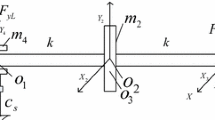Abstract
The physical significance of the transient proper orthogonal decomposition (TPOD) method is proposed based on the energy of the proper orthogonal mode (POM). The POM energy can reveal the amount occupation of the dynamical characteristics of the reduced model relative to the original one. The TPOD method is compared with the traditional POD method; the bifurcation diagrams and the transition curves of POM energy are applied to verify the efficiency and accuracy of the TPOD method. On the basis of the POM energy analysis, the optimal order reduction model can be provided by the TPOD method. Two examples of the rotor-bearing systems are established by the Newton’s second law to study the physical significance of the TPOD method: One is the rotor system with pedestal looseness at one end and the other is looseness at both ends. The effects of the initial conditions (displacement and velocity) to the frequency components of the original systems and the order reduction efficiency are discussed. The variations of the frequency components can provide the guidance to the fault detections of the rotor systems.













Similar content being viewed by others
References
Muszynska, A.: Rotor-to-stationary element rub-related vibration phenomena in rotating machinery-literature survey. Shock Vib. Dig. 21, 3–11 (1989)
Jacquet, R.G., Torkhani, M., Cartraud, P., Thouverez, F., Baranger, T.N., Herran, M., Gibert, C., Baguet, S., Almeida, P., Peletan, L.: Rotor to stator contacts in turbomachines. Review and application. Mech. Syst. Signal Process. 40, 401–420 (2013)
Khanlo, H.M., Ghayour, M., Ziaei, R.S.: Chaotic vibration analysis of rotating, flexible, continuous shaft-disk system with a rub-impact between the disk and the stator. Commun. Nonlinear Sci. Numer. Simul. 16, 566–582 (2011)
Hou, L., Chen, Y.S., Cao, Q.J.: Nonlinear vibration phenomenon of an aircraft rub-impact rotor system due to hovering flight. Commun. Nonlinear Sci. Numer. Simul. 19, 286–297 (2014)
Hou, L., Chen, Y.S., Lu, Z.Y., Li, Z.G.: Bifurcation analysis for 2:1 and 3:1 super-harmonic resonances of an aircraft cracked rotor system due to maneuver load. Nonlinear Dyn. 81(1), 531–547 (2015)
AL-Shudeifat, M.A., Butcher, E.A., Stem, C.R.: General harmonic balance solution of a cracked rotor-bearing-disk system for harmonic and sub-harmonic analysis: Analytical and experimental approach. Int. J. Eng. Sci. 48, 921–935 (2010)
AL-Shudeifat, M.A., Butcher, E.A.: New breathing functions for the transverse breathing crack of the cracked rotor system: approach for critical and subcritical harmonic analysis. J. Sound Vib. 330, 526–554 (2011)
Han, Q.K., Chu, F.L.: Parametric instability of a Jeffcott rotor with rotationally asymmetric inertia and transverse crack. Nonlinear Dyn. 73, 827–842 (2013)
Lees, A.W.: Misalignment in rigidly coupled rotors. J. Sound Vib. 305, 261–271 (2007)
AL-Hussain, K.M., Redmond, I.: Dynamic response of two rotors connected by rigid mechanical coupling with parallel misalignment. J. Sound Vib. 249(3), 483–498 (2002)
Li, B., Chow, M.Y., Tipsuwan, Y., Hung, J.C.: Neural-network-based motor rolling bearing fault diagnosis. IEEE Trans. Ind. Electron. 47(5), 1060–1069 (2000)
Rai, V.K., Mohanty, A.R.: Bearing fault diagnosis using FFT of intrinsic mode functions in Hilbert-Huang transform. Mech. Syst. Signal Process. 21, 2607–2615 (2007)
Prabhakar, S., Mohanty, A.R., Sekhar, A.S.: Application of discrete wavelet transform for detection of ball bearing race faults. Tribol. Int. 35, 793–800 (2002)
Chu, F.L., Tang, Y.: Stability and nonlinear responses of a rotor-bearing system with pedestal looseness. J. Sound Vib. 241(5), 879–893 (2001)
Ma, H., Zhao, X.Y., Teng, Y.N., Wen, B.C.: Analysis of dynamic characteristics for a rotor system with pedestal looseness. Shock Vib. 18, 13–27 (2011)
Ji, Z., Zu, J.W.: Method of multiple scales for vibration analysis of rotor-shaft systems with nonlinear bearing pedestal model. J. Sound Vib. 218(2), 293–305 (1998)
Muszynska, A., Goldman, P.: Chaotic responses of unbalanced rotor/bearing/stator systems with looseness or rubs. Chaos Solitons Fractals 5(9), 1683–1704 (1995)
Goldman, P., Muszynska, A.: Analytical and experimental simulation of loose pedestal dynamic effects on a rotating machine vibrational response. Rotating Mach. Veh. Dyn. ASME 35, 11–17 (1991)
Liang, Y.C., Lee, H.P., Lim, S.P., Lin, W.Z., Lee, K.H., Wu, C.G.: Proper orthogonal decomposition and its applications, part I: theory. J. Sound Vib. 252(3), 527–544 (2002)
Yu, H., Chen, Y.S., Cao, Q.J.: Bifurcation analysis for nonlinear multi-degree-of-freedom rotor system with liquid-film lubricated bearings. Appl. Math. Mech. Eng. 34(6), 777–790 (2013)
Lu, K., Yu, H., Chen, Y.S., Cao, Q.J., Hou, L.: A modified nonlinear POD method for order reduction based on transient time series. Nonlinear Dyn. 79(2), 1195–1206 (2015)
Lu, K., Jin, Y.L., Chen, Y.S., Cao, Q.J., Zhang, Z.Y.: Stability analysis of reduced rotor pedestal looseness fault model. Nonlinear Dyn. 82(4), 1611–1622 (2015)
Kerschen, G., Golinval, J.C., Vakakis, A.F., Bergman, L.A.: The method of proper orthogonal decomposition for dynamical characterization and order reduction of mechanical systems: An overview. Nonlinear Dyn. 41, 147–169 (2005)
Smith, T.R., Moehlis, J., Holmes, P.: Low-dimensional modeling of turbulence using the proper orthogonal decomposition: a tutorial. Nonlinear Dyn. 41, 275–307 (2005)
Feeny, B.F., Kappagantu, R.: On the physical interpretation of proper orthogonal modes in vibration. J. Sound Vib. 211, 607–616 (1998)
Holmes, P., Lumley, J.L., Berkooz, G.: Turbulence, Coherent Structures, Dynamical Systems and Symmetry. Cambridge University Press, New York (1996)
Kerschen, G., Golinval, J.C.: Physical interpretation of the proper orthogonal modes using the singular value decomposition. J. Sound Vib. 249(5), 849–865 (2002)
Adiletta, G., Guido, A.R., Rossi, C.: Chaotic motions of a rigid rotor in short journal bearings. Nonlinear Dyn. 10, 251–269 (1996)
Acknowledgments
We are grateful for the valuable suggestions of the editors and the reviewers. We appreciate for the support of the China Scholarship Council and the guidance of professor Sharif Rahman in the university of Iowa. The authors would also like to acknowledge the financial supports from the National Basic Research Program (973 Program) of China (Grant No. 2015CB057405).
Author information
Authors and Affiliations
Corresponding author
Appendix
Appendix

Rights and permissions
About this article
Cite this article
Lu, K., Chen, Y., Jin, Y. et al. Application of the transient proper orthogonal decomposition method for order reduction of rotor systems with faults. Nonlinear Dyn 86, 1913–1926 (2016). https://doi.org/10.1007/s11071-016-3004-x
Received:
Accepted:
Published:
Issue Date:
DOI: https://doi.org/10.1007/s11071-016-3004-x




